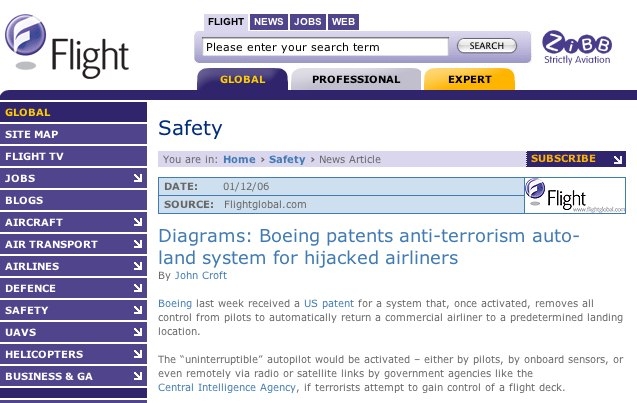
www.flightglobal.com/Articles/2006/12/01/210869/Diagrams+Boeing+patents+anti-terrorism+auto-land+system+for+hijacked.html

www.flightglobal.com/Articles/2006/12/01/210869/Diagrams+Boeing+patents+anti-terrorism+auto-land+system+for+hijacked.html
DATE:01/12/06 (December 1, 2006)
SOURCE: Flightglobal.com
Diagrams: Boeing patents anti-terrorism auto-land system for hijacked
airliners
By John Croft
Boeing last week received a US patent for a system that, once activated, removes all control from pilots to automatically return a commercial airliner to a predetermined landing location.
The “uninterruptible” autopilot would be activated – either by pilots, by onboard sensors, or even remotely via radio or satellite links by government agencies like the Central Intelligence Agency, if terrorists attempt to gain control of a flight deck.
Boeing says: "We are constantly studying ways we can enhance the safety, security and effiecency of the world's airline fleet."
“There is a need in the industry for a technique that conclusively prevents unauthorised persons for gaining access to the controls of the vehicle and therefore threatening the safety of the passengers onboard the vehicle, and/or other people in the path of travel of the vehicle, thereby decreasing the amount of destruction individuals onboard the vehicle would be capable of causing,” the patent authors write. “In particular, there is a need for a technique that ensures the continuation of the desired path of travel of a vehicle by removing any type of human decision process that may be influenced by the circumstances of the situation, including threats or further violence onboard the vehicle.”
According to the patent, existing preventative measures are less than fullproof – pilots can decide to open the lockable, bullet-proof cockpit doors and federal air marshals can be overpowered and de-armed. Boeing’s alternative has an onboard processor that once activated, disallows pilot inputs and prevents anyone on board from interrupting an emergency landing plan that can be predefined or radioed to the aircraft by airline or government controllers and carried out by the aircraft’s guidance and control system. To make it fully independent, the system has its own power supply, independent of the aircraft’s circuit breakers. The aircraft remains in automatic mode until after landing, when mechanics or government security operatives are called in to disengage the system.
Boeing envisions several methods of activating the system. Options include manual switches for pilots to hit, or possibly force sensors on the cockpit door that would trip the anti-terror mode if a minimum force threshold were crossed, for instance if someone were trying to break down the door. Another option is a remote link whereby airline or government workers in ground facilities would monitor and aircraft and command the automatic control mode “once it is determined that the security of the air vehicle is in jeopardy.” Radio links could also be used to inform ground facilities and nearby aircraft that an aircraft has been placed in the automatic flight mode.
It’s unclear if the Boeing work is related to last week’s issuance of a $1.9 million US Federal Aviation Administration contract to Raytheon for an Advanced Route Evaluation System (ARES). According to Raytheon, ARES will perform risk analysis on aviation routes to help planners determine the best routes for aircraft to use during emergencies.”
Aside from the safety and security aspects of having such a system, Boeing sees it as a preventative measure: “Once the automatic control system provided by the present invention is initiated, no one on board the air vehicle is capable controlling the flight to the air vehicle, such that it would be useless for anyone to threaten violence in order to gain control the air vehicle.”
United States Patent: 7142971
granted to the Boeing company, November 28, 2006
System and method for automatically controlling a path of travel of a
vehicle